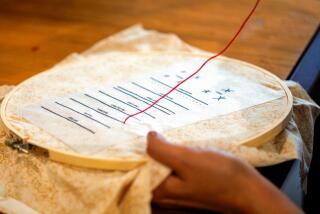BY DESIGN : Just Dye It : Stained your favorite jacket, blouse or skirt? If it’s made of natural fibers and is only slightly soiled, the garment may be a candidate for dyeing-- or maybe not.
- Share via
Let’s face it, those off-white colors that were the height of spring fashion are now more off than white. It isn’t that they weren’t lovely in May--it’s just that by September the pristine pales aren’t so pristine anymore.
The near-whites showed their age quickly. A little wine here, a little salad oil there, some soy sauce on the cuff and what have you got? A wardrobe that looks like an array of tablecloths and a big dry-cleaning bill. No wonder black was so popular for so long.
There is a cure for the summertime beige: dyeing.
Is your stained garment made of natural fibers? Is it only slightly stained? Will you care if the dye job does not work? If you can answer yes to all of the above, consider dyeing. (Otherwise, give the garment away, then go stimulate the local retail economy by buying a new one. Whatever it was.)
This next little fact should separate the truly interested from the merely curious: The cost of having a jacket professionally dyed can run $40 to $80.
If you have washed your garment in your washing machine, you can dye it there too. But if the care label suggests dry cleaning, dyeing must be done by a professional.
These days, unfortunately, most dry cleaners will not accept dye jobs. Dyeing is a dying art. Years ago the professional garment cleaners guild was know as the Dyers and Scourers guild. Today, dyers are few and far between. The good ones are employed by the industrial dye houses. Scourers were elevated by technology into dry cleaners.
Those dry cleaners that do accept dye jobs do so only at the customer’s insistence, and even then, management refuses to guarantee the results.
“Dyeing isn’t a magic wand you can just wave over a garment and expect miracles to happen,” says Richard Rayner, manager of Sterling Cleaners in Beverly Hills.
There are too many variables, dry cleaners say, none so critical as fabric content. Natural fibers--such as cotton, silk and linen--dye well. Rayon accepts dye fairly well. Polyester and other synthetics, however, are almost impossible to dye. Because these fibers are not porous, intense heat is required to make dye permeate the thread. The heat is so high that it damages most garments.
Wool is a natural fiber, but because dyeing is a water-based process, wool garments are apt to shrink in the process. This can also be a problem for some silks and linen.
*
Stains are another sticky wicket. A grease stain, for example, coats the fiber of a garment, making it harder for the dye to penetrate. A grease-stained garment should be cleaned before dyeing. Even then, the oil-saturated fiber will dye differently than the area around it.
A food stain, such as wine, tomato or soy sauce, will color the fabric--in essence, dyeing it. Often the food color will accept dye differently, perpetuating the stain problem.
If there is a great deal of color discrepancy between the stain and the fabric, only extremely dark colors--such as navy or black--are likely to cover both in such a way as to make the stain blend with the fabric.
Conversely, bleach marks on dark garments are tough to dye over. Bleaching changes the composition of the fiber and the mark will always be lighter than the surrounding fabric.
Even if your garment is stain-free, trims and stitching can be a problem. Most thread is polyester, and it won’t always dye the same color as the garment. Bugle beads and sequins are their own little nightmare, often picking up the dye when you don’t want them to.
Cleaners who do accept dyeing assignments often pass the job along to specialty cleaners. Those cleaners in turn will pass along color jobs to dye specialists.
There the buck stops and the dye flows. Two to three weeks later, the newly colored garment passes back down the pipeline. And, naturally, the bill gets marked up as it goes through each of the helping hands.
*
Brownie’s Suede and Leather Cleaners in Huntington Beach is a specialty cleaners. “We service 700 to 800 cleaners in Orange, San Bernardino and Riverside counties,” owner Roger Smith says. “We’re a supplementary service. We clean items such as leather coats, hats and gloves, but I don’t do dye work. That I pass along to a dye house in Culver City.”
Smith sends all his dye jobs to Michael Faeth of Studio Cleaners. “That guy owns almost all the business in L.A.” Smith says.
“We probably have a 90% success rate,” Faeth says. But dyeing is done at the customer’s risk, he says. “Most things that people bring in are things they aren’t going to wear anyway. So the $15 to $35 isn’t that great a risk.”
Even with dye jobs from more than 700 cleaners pouring into his shop, Faeth says that is a small portion of his work. The bulk of his business comes from hotels, television and film studios.
Two other companies that do dye work on their premises also have strong ties to the studios: La Cienega Cleaners in West Hollywood and A Dyeing Art in Glendale.
Edwinna Pellikan, who owns A Dyeing Art, is one of the bravest of all the dyers. She has been known to dip Armani suits in her dye baths.
Pellikan’s skill does not come cheap. She charges $80 to dye a jacket, but she is recognized as one of the artists of the industry.
Her assistant, Art Perez, says there isn’t a color they can’t match: “If a customer can dream in color, we can match it.”






